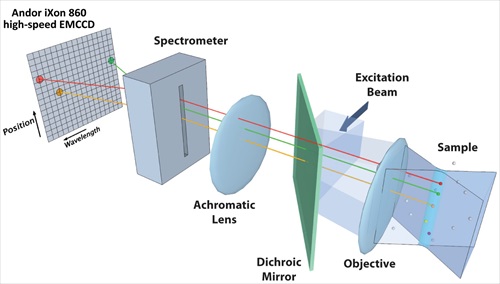Members Login

Channels
Special Offers & Promotions
Andor iXon 860 EMCCD powers direct video recording of Cell Signalling Complexes
Albuquerque team designs unique, high-speed hyperspectral microscope to visualise membrane receptor dynamics at the molecular level in living cells
A unique hyperspectral microscope (HSM) designed specifically to visualise molecular-level protein-protein interactions in living cells has been unveiled recently by the University of Albuquerque. Designed around an Andor iXon 860 high-speed EMCCD detection system to record these profoundly challenging nanometer-scale events, the microscope delivers an unprecedented combination of speed, sensitivity and spectral detection.
The novel design of the HSM provides acquisition rates of 27 fps over a 28 square micrometre field of view with each pixel collecting 128 spectral channels, allowing the determination of stoichiometry and dynamics of small oligomers unmeasurable by any other technique. Led by Professor Keith Lidke, the New Mexico team performed single particle tracking of up to 8 spectrally distinct species of quantum dots (QDs), the distinct emission spectra of the QDs allowing localization with approx. 10 nm precision even when the probes were clustered at spatial scales below the diffraction limit.
"Many cellular signaling processes are initiated by dimerization or oligomerization of membrane proteins," says Professor Lidke. "However, since the spatial scale of these interactions is below the diffraction limit of the light microscope, the dynamics of these interactions have been difficult to study in living cells. Our unique, high-speed HSM enables multi-color single particle tracking of up to eight different probes simultaneously and has allowed us to directly observe the behaviour of small signaling complexes that cannot be resolved with other diffraction-limited light microscopy techniques.
"We chose the Andor iXon 860 EMCCD camera to capture our signals because this demanding application involving high-speed acquisition under very low light conditions places real demands on detector technology to perform at significantly higher levels of sensitivity and speed. Our imaging approach uses a spectrometer to spread light from 500 nm to 750 nm across 128 pixels of the camera. In our typical, high-speed configuration, we use half the camera and run at approx. 1,000 fps with most pixels collecting just a few photons per frame. Electron Multiplying CCD (EMCCD) technology, as seen in the Andor iXon camera, amplifies down to single photons and is ideal for these studies," concludes Lidke.
According to Antoine Varagnat, product specialist at Andor, "The Andor iXon 860 EMCCD camera was able to meet the very challenging detection requirements of Professor Lidke's superfast hyperspectral microscope, namely ultra-low light detection at frame rates exceeding 1 kHz. This level of performance was a key enabler for the team for the development of suitable tools for the study of the organization and dynamics of their specific cellular components.
"In their exciting paper, the capabilities of the new microscope were demonstrated by the application of high-resolution, spectrally-based particle tracking to observe membrane protein behaviour, including, for example, the dynamic formation and dissociation of Epidermal Growth Factor Receptor dimers, four-colour QD tracking while simultaneously visualizing GFP-actin and high-density tracking for fast diffusion mapping."
Media Partners



